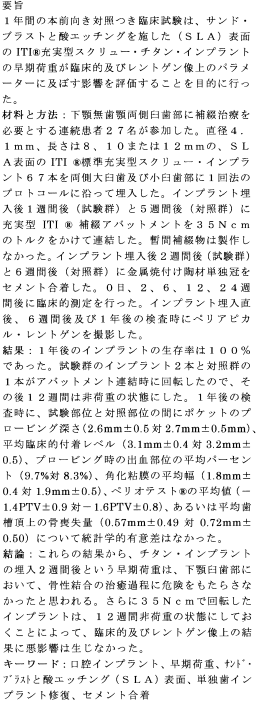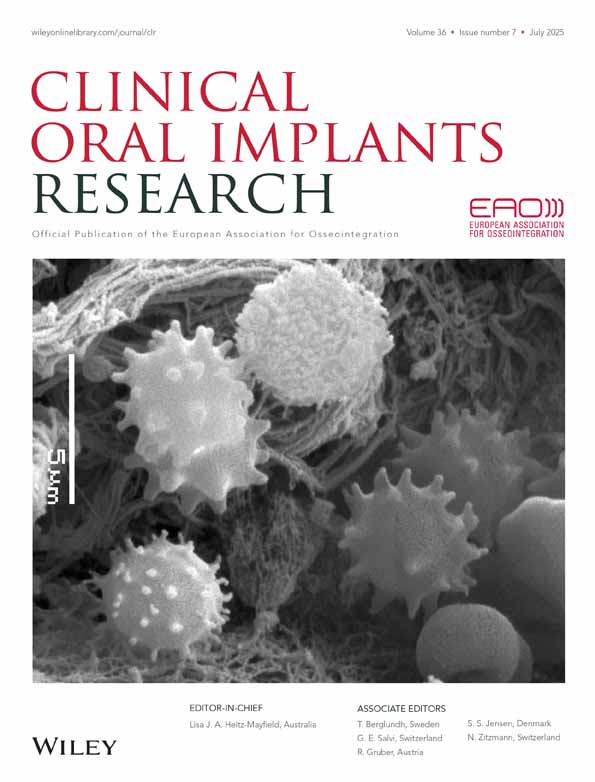Early loading (2 or 6 weeks) of sandblasted and acid-etched (SLA) ITI® implants in the posterior mandible
Das Ziel dieser prospektiven kontrollierten klinischen Untersuchung über ein Jahr war es, den Einfluss einer frühen Belastung von ITI® Vollschraubentitanimplantaten mit sandgestrahlten und säuregeäzten (SLA) Oberflächen auf klinische und radiologische Parameter zu untersuchen.
A 1-year randomized controlled clinical trial
Abstract
enAbstract: The aim of this 1-year prospective controlled clinical trial was to evaluate the effect of early loading of ITI® solid screw titanium implants with a sandblasted and acid-etched (SLA) surface on clinical and radiographic parameters.
Material and methods: Twenty-seven consecutively admitted patients presenting bilateral edentulous posterior mandibular areas and in need of prosthetic reconstruction were recruited. Sixty-seven ITI® standard solid screw implants with an SLA surface, a diameter of 4.1 mm and a length of 8, 10 or 12 mm were installed bilaterally in molar and premolar areas according to a one-stage surgical protocol. One week (test) and 5 weeks (control) after implant placement, solid ITI® prosthetic abutments were connected using a torque of 35 N cm. No provisional restoration was fabricated. Two weeks (test) and 6 weeks (control) after implant placement, porcelain-fused-to-metal single-tooth crowns were cemented. Clinical measurements were obtained at day 0 and 2, 6, 12, 24 and 52 weeks thereafter. Periapical radiographs were taken immediately after implant placement, after 6 weeks and at the 1-year examination.
Results: After 1 year, implant survival was 100%. Two test and one control implants rotated at the time of abutment connection and were left unloaded for 12 additional weeks. At the 1-year examination, no statistically significant differences were found between the test and control sites with respect to pocket probing depths (2.6 mm±0.5 vs. 2.7 mm±0.5), mean clinical attachment levels (3.1 mm±0.4 vs. 3.2 mm±0.5), mean percentages of sites bleeding on probing (9.7% vs. 8.3%), mean widths of keratinized mucosa (1.8 mm±0.4 vs. 1.9 mm±0.5), mean PerioTest® values (−1.4 PTV±0.9 vs. −1.6 PTV±0.8) or mean crestal bone loss measurements (0.57 mm±0.49 vs. 0.72 mm±0.50).
Conclusion: Based on these results, loading of titanium implants with an SLA surface as early as 2 weeks did not appear to jeopardize the osseointegration healing process in the posterior mandible. Furthermore, implants rotating at 35 N cm, if left unloaded for additional 12 weeks, did not negatively affect clinical and radiographic outcomes.
Résumé
frLe but de cet essai clinique contrôlé prospectif d'une année a été d'évaluer l'effet de la mise en charge précoce d'implants en titane vis solide ITI® avec une surface sablée et mordancée (SLA) sur des paramètres cliniques et radiographiques. Vingt-sept patients présentant des aires bilatérales mandibulaires postérieures édentées et nécessitant donc une reconstruction prothétique ont été recrutés. Soixante-sept implants ITI® d'un diamètre de 4,1 mm et d'une longueur de 8, 10 ou 12 mm ont été placés bilatéralement dans les zones molaires et prémolaires suivant le processus chirurgical en une étape. Une semaine (test) et cinq semaines (contrôle) après leur placement des piliers prothétiques ITI® ont été serrés avec une force de 35 Ncm. Aucune restauration provisoire n'a été fabriquée. Deux semaines (test) et six semaines (contrôle) après le placement des implants des couronnes céramo-métalliques indépendantes ont été cimentées. Des mesures cliniques ont été obtenues aux jours 0 et deux, et aux semaines 6, 12, 24 et 52. Des radiographies périapicales ont été prises immédiatement après le placement des implants, après six semaines et une année. Après une année, le taux de survie implantaire était de 100%. Deux implants tests et un contrôle pivotaient au moment de la connexion du pilier et ont été laissés non-chargés pour 12 semaines supplémentaires. Après une année, aucune différence statistique n'a été trouvée entre les sites tests et contrôles en ce qui concerne les profondeurs de poches au sondage (2,6 ±0,5 mm vs 2,7± 0,5 mm), les niveaux d'attache clinique moyens (3,1±0,4 vs 3,2±0,5 mm,) les pourcentages moyens de sites saignant au sondage (9,7% vs 8,3%), les largeurs moyennes de muqueuse attachée (1,8±0,4 mm vs 1,9±0,5 mm), les valeurs Periotest moyennes (−1,4±0,9 PTV vs −1,6 ±0,8 PTV) ou les mesures de perte osseuse crestale moyennes (0,57 ± 0,49 mm vs 0,72±0,52 mm). La charge d'implants en titane avec surface SLA aussitôt que deux semaines après leur placement ne semblait pas mettre en danger le processus d'ostéoïntégration dans la partie postérieure de la mandibule. De plus, les implants pivotant à 35 Ncm, si laissés non-chargés pour douze semaines supplémentaires, n'affectaient pas de manière négative les mesures cliniques et radiographiques.
Zusammenfassung
deMaterial und Methoden: Es wurden siebenundzwanzig Patienten mit beidseits zahnlosem Seitenzahnbereich im Unterkiefer, welche eine prothetische Versorgung benötigten, in die Studie aufgenommen. Es wurden 67 ITI® Standard Vollschraubenimplantate mit einem Durchmesser von 4.1 mm und einer Länge von 8, 10 oder 12 mm beidseits in der Molaren- und Prämolarenregion transmukosal eingesetzt. Eine Woche (Test) und 5 Wochen (Kontrolle) nach Implantation wurden ITI® Massivsekundärteile mit einem Drehmoment von 35 Ncm eingesetzt. Es wurde keine provisorische Versorgung angefertigt. Zwei Wochen (Test) und 6 Wochen (Kontrolle) nach Implantation wurden Gold-Porzellan Einzelkronen einzementiert. Klinische Messungen wurden am Tag 0 und nach 2, 6, 12, 24, und 52 Wochen aufgenommen. Periapikale Röntgenaufnahmen wurden sofort nach der Implantation, nach 6 Wochen und anlässlich der 1 Jahreskontrolle angefertigt.
Resultate: Nach einem Jahr betrug die Implanta-tüberlebensrate 100%. Zwei Test- und ein Kontrollimplantat drehten sich beim Einschrauben der Sekundärteile und wurden für zusätzliche 12 Wochen unbelastet belassen. Bei der 1 Jahresuntersuchung konnten zwischen Test- und Kontrolli-mplantaten keine statistisch signifikanten Unterschiede bezüglich Sondierungswerten (2.6mm+/−0.5 gegenüber 2.7mm +/−0.5), mittlerem klinischem Attachmentniveau (3.1mm +/−0.4 gegenüber 3.2mm +/−0.5), mittlerem Prozentanteil beim Bluten auf Sondieren (9.7% gegenüber 8.3%), mittlerer Breite der keratinisierten Mukosa (1.8mm +/−0.4 gegenüber 1.9mm +/−0.5), mittleren Periotest® Werten (−1.4 PTV +/−0.9 gegenüber −1.6 PTV +/−0.8) oder mittlerem marginalem Knochenverlust (0.57mm +/−0.49 gegenüber 0.72mm +/−0.50) gefunden werden.
Schlussfolgerung: Gemäss dieser Resultate schien die Belastung von Titanimplantaten mit SLA Oberfäche bereits nach 2 Wochen den Heilungsprozess der Osseointegration im posterioren Unterkiefer nicht zu beeinträchtigen. Implantate, die bei 35Ncm rotierten und daraufhin für weitere 12 Wochen unbelastet blieben, beeinflussten die klinischen und radiologischen Resultate nicht negativ.
Resumen
esLa intención de este ensayo clínico prospectivo controlado fue evaluar el efecto de una carga temprana sobre implantes macizos roscados de titanio con una superficie pulverizada con arena y gravada con ácido (SLA) sobre parámetros clínicos y radiográficos.
Material y Métodos: Se reclutaron veintisiete pacientes consecutivamente admitidos que presentaron áreas edéntulas bilaterales en la mandíbula posterior y necesitando reconstrucción protésica. Se instalaron bilateralmente en las áreas molar y premolar sesenta y siete implantes ITI® estándar macizos roscados de titanio con una superficie SLA, un diámetro de 4.1 mm y una longitud de 8, 10 o 12 mm de acuerdo con un protocolo quirúrgico de una sola fase. Una semana (prueba) y 5 semanas (control) tras la colocación del implante, se conectaron pilares prostéticos macizos ITI usando un torque de 35 Ncm. No se fabricaron restauraciones provisionales. Dos semanas (prueba) y 6 semanas (control) tras la colocación de los implantes, se cementaron coronas unitarias metalocerámicas. Se obtuvieron medidas clínicas en el día 0 y tras 2, 6, 12, 24 y 52 semanas. Se tomaron radiografías periapicales inmediatamente tras la colocación del implante, a las 6 semanas y en el examen de 1 año.
Resultados: Tras 1 año, la supervivencia de los implantes fue del 100%. Dos implantes de prueba y uno de control rotaron en el momento de la conexión del pilar y se dejaron sin carga durante 12 semanas más. En el examen de 1 año, no se encontraron diferencias significativas entre los lugares de prueba y los de control respecto a las profundidades de sondaje (2.6 mm±0.5 vs. 2.7 mm±0.5), niveles medios de inserción clínica (3.1±mm±0.4 vs. 3.2 mm±0.5), porcentaje medio de lugares con sangrado al sondaje (9.7% vs. 8.3%), anchura media de mucosa queratinizada (1.8 mm±0.4 vs. 1.9 mm±0.5), valores medios de Perio Test® (−1.4 PTV±0.9 vs. −1.6 PTV±0.8) o a las medidas medias de perdida de hueso crestal (0.57 mm±0.49 vs. 0.72 mm±0.50).
Conclusiones: Basándose en estos resultados, la carga de implantes de titanio con superficie SLA tan pronto como a las 2 semanas no pareció comprometer el proceso de cicatrización de la osteointegración en la mandíbula posterior. Mas aun, los implantes que rotaron a 35 Ncm, si se dejan sin carga durante 12 semanas más, no afectaron negativamente los resultados clínicos y radiográficos.





